Equipment Sizing and Operation Strategy of Photovoltaic-Powered Hydrogen Refueling Station Based on AE-PEM Coupled Hydrogen Production
Abstract
1. Introduction
2. Model of the Hydrogen Refueling Station
2.1. Model of Alkaline Electrolyzer
2.2. Model of PEM
2.3. Model of Compressor
2.4. Model of Hydrogen Storage Tank
2.5. Model of Capacitance
2.6. Model of Hydrogen Cell
2.7. Model of Energy Storage Battery
3. Hydrogenation Station Operation Scheme
3.1. Operation Scheme of Electrolytic Cell
3.2. Hydrogen Storage Tank Operation Scheme
3.3. Energy Storage Battery Operation Plan
3.4. Balance Constraints
3.5. Objective Function
3.6. Hydrogen Fuel Cell Operation Scheme
4. Case Study
4.1. Data Preparation
4.2. Equipment Sizing Results
4.3. Operation Results
5. Conclusions
- Hybrid AE-PEM hydrogen production: The hybrid approach leverages the low cost of an AE and the rapid response of a PEM to better adapt to PV power fluctuations. This combination mitigates the high investment cost of the PEM and the slow dynamic response of the AE, resulting in a more efficient and cost-effective hydrogen production system.
- Operational strategy: The proposed operational strategy uses capacitors to filter high-frequency components of PV power generation and energy storage batteries to perform peak shaving and valley filling on the low-frequency PV output curve. This enables the electrolyzers to operate more steadily, improving hydrogen production efficiency and extending the lifespan of the equipment.
- Cost savings: The case study demonstrates that the hybrid AE-PEM hydrogen production mode can fully utilize all PV power generation while significantly reducing annual costs. Specifically, the annual cost of the hybrid hydrogen refueling station is 143,250 USD lower than that of a station using only AEs and 196,970 USD lower than that of a station using only PEM electrolyzers. This represents a cost reduction of 4.3% and 5.9%, respectively.
- PV fluctuation mitigation: The use of capacitors and energy storage batteries reduces the variance of PV power output by approximately 0.02, enabling more stable operation of the electrolyzers.
Author Contributions
Funding
Data Availability Statement
Conflicts of Interest
Appendix A
|
START // Initialize components and parameters Initialize AE (alkaline electrolyzer) Initialize PEM (Proton Exchange Membrane) electrolyzer Initialize Compressor Initialize HydrogenStorageTank Initialize Capacitor Initialize HydrogenFuelCell Initialize EnergyStorageBattery Initialize PLC (Programmable Logic Controller) // Main loop for hydrogen refueling station operation WHILE TRUE DO // Step 1: Monitor power sources (photovoltaic, grid, battery) IF PhotovoltaicPower > 0 THEN PowerSource = PhotovoltaicPower FilterHighFrequencyComponents(PowerSource, Capacitor) ELSE IF GridPower > 0 THEN PowerSource = GridPower ELSE PowerSource = EnergyStorageBattery.Discharge() END IF // Step 2: AE and PEM hydrogen production IF PowerSource > 0 THEN // AE hydrogen production IF AE.StartupTime ≥ 1 h AND AE.ShutdownTime ≥ several minutes THEN AE.PowerConsumption = CalculateAEPowerConsumption(PowerSource) IF AE.PowerConsumption ≥ 0.4 × AE.RatedPower AND AE.PowerConsumption ≤ 1.1 × AE.RatedPower THEN AE.HydrogenProduction = CalculateAEHydrogenProduction(AE.PowerConsumption) HydrogenStorageTank.Store(AE.HydrogenProduction) END IF END IF // PEM hydrogen production IF PEM.StartupTime ≥ 5 min AND PEM.ShutdownTime ≥ 1 min THEN PEM.PowerConsumption = CalculatePEMPowerConsumption(PowerSource) IF PEM.PowerConsumption ≥ 0.1 × PEM.RatedPower AND PEM.PowerConsumption ≤ 1.2 × PEM.RatedPower THEN PEM.HydrogenProduction = CalculatePEMHydrogenProduction(PEM.PowerConsumption) HydrogenStorageTank.Store(PEM.HydrogenProduction) END IF END IF END IF // Step 3: Compress and store hydrogen IF HydrogenStorageTank.HydrogenMass > Compressor.Threshold THEN CompressedHydrogen = Compressor.Compress(HydrogenStorageTank.HydrogenMass) HydrogenStorageTank.Store(CompressedHydrogen) END IF // Step 4: Dispense hydrogen to users or fuel cell IF HydrogenDemand > 0 THEN IF HydrogenStorageTank.HydrogenMass > HydrogenDemand THEN DispenseHydrogen(HydrogenDemand) ELSE PRINT “Insufficient hydrogen in storage tank” END IF ELSE ExcessHydrogen = HydrogenStorageTank.HydrogenMass − HydrogenStorageTank.Capacity IF ExcessHydrogen > 0 THEN HydrogenFuelCell.GenerateElectricity(ExcessHydrogen) END IF END IF // Step 5: Monitor and control system via PLC PLC.Monitor(AE, PEM, Compressor, HydrogenStorageTank, Capacitor, HydrogenFuelCell, EnergyStorageBattery) END WHILE END |
References
- Blanchette, S. A hydrogen economy and its impact on the world as we know it. Energy Policy 2008, 36, 522–530. [Google Scholar] [CrossRef]
- Muratori, M.; Bush, B.; Hunter, C.; Melaina, M.W. Modeling Hydrogen Refueling Infrastructure to Support Passenger Vehicles. Energies 2018, 11, 1171. [Google Scholar] [CrossRef]
- National Energy Administration. Medium and Long-Term Plan for the Development of Hydrogen Energy Industry (2021–2035). Available online: http://zfxxgk.nea.gov.cn/1310525630_16479984022991n.pdf (accessed on 3 March 2024).
- Federal Ministry of Transport. Building and Urban Development (BMVBS), the Mobility and Fuels Strategy of the German Government (MFS). 2013. Available online: https://www.h2euro.org/wp-content/uploads/2013/09/German-Mobility-and-Fuels-Strategy.pdf (accessed on 1 March 2024).
- State of California. AB-8 Alternative Fuel and Vehicletechnologies: Funding Programs. 2013. Available online: http://leginfo.legislature.ca.gov/faces/billTextClient.xhtml?bill_id=201320140AB8 (accessed on 1 March 2024).
- Aki, H.; Sugimoto, I.; Sugai, T. Optimal operation of a photovoltaic generation-powered hydrogen production system at a hydrogen refueling station. Int. J. Hydrogen Energy 2018, 43, 14892–14904. [Google Scholar] [CrossRef]
- Bartolucci, L.; Cordiner, S.; Mulone, V.; Pasquale, S. Hydrogen based multi energy systems: Assessment of the marginal utility of increasing hydrogen penetration on system performances. Int. J. Hydrogen Energy 2021, 46, 38588e602. [Google Scholar] [CrossRef]
- Al-Sharafi, A.; Al-Buraiki, A.S.; Al-Sulaiman, F.; Antar, M.A. Hydrogen refueling stations powered by hybrid PV/wind renewable energy systems: Techno-socio-economic assessment. Energy Convers. Manag. X 2024, 22, 100584. [Google Scholar] [CrossRef]
- Micena, R.P.; Llerena-Pizarro, O.R.; de Souza, T.M.; Silveira, J.L. Solar-powered Hydrogen Refueling Stations: A techno-economic analysis. Int. J. Hydrogen Energy 2020, 45, 2308–2318. [Google Scholar] [CrossRef]
- Atabay, R.; Devrim, Y. Design and techno-economic analysis of solar energy based on-site hydrogen refueling station. Int. J. Hydrogen Energy 2024, 80, 151–160. [Google Scholar] [CrossRef]
- Rizk-Allah, R.M.; Hassan, I.A.; Snasel, V.; Hassanien, A.E. An optimal standalone wind-photovoltaic power plant system for green hydrogen generation: Case study for hydrogen refueling station. Results Eng. 2024, 22, 102234. [Google Scholar] [CrossRef]
- Hemmati, R.; Bornapour, S.M.; Saboori, H. Standalone hybrid power-hydrogen system incorporating daily-seasonal green hydrogen storage and hydrogen refueling station. Energy 2024, 295, 131122. [Google Scholar] [CrossRef]
- Gökçek, M.; Paltrinieri, N.; Liu, Y.; Badia, E.; Dokuz, A.Ş.; Erdoğmuş, A.; Urhan, B.B.; Yoldaş, Ö. Optimum sizing of hybrid renewable power systems for on-site hydrogen refuelling stations: Case studies from Türkiye and Spain. Int. J. Hydrogen Energy 2024, 59, 715–729. [Google Scholar] [CrossRef]
- Zghaibeh, M.; Belgacem, I.B.; Baloch, M.H.; Chauhdary, S.T.; Kumar, L.; Arıcı, M. Optimization of green hydrogen production in hydroelectric-photovoltaic grid connected power station. Int. J. Hydrogen Energy 2024, 52, 440–453. [Google Scholar] [CrossRef]
- Roslan, M.F.; Ramachandaramurthy, V.K.; Mansor, M.; Mokhzani, A.S.; Jern, K.P.; Begum, R.A.; Hannan, M.A. Techno-economic impact analysis for renewable energy-based hydrogen storage integrated grid electric vehicle charging stations in different potential locations of Malaysia. Energy Strategy Rev. 2024, 54, 101478. [Google Scholar] [CrossRef]
- Hajjaji, M.; Cristofari, C. Economic and technical evaluation of on-site electrolysis solar hydrogen refueling station in Corsica: A case study of Ajaccio. Renew. Energy 2024, 231, 120982. [Google Scholar] [CrossRef]
- Yang, Y.; Xu, X.; Luo, Y.; Liu, J.; Hu, W. Distributionally robust planning method for expressway hydrogen refueling station powered by a wind-PV system. Renew. Energy 2024, 225, 120210. [Google Scholar] [CrossRef]
- Bhogilla, S.S.; Niyas, H. Design of a hydrogen compressor for hydrogen fueling stations. Int. J. Hydrogen Energy 2019, 44, 29329–29337. [Google Scholar] [CrossRef]
- Specklin, M.; Deligant, M.; Sapin, P.; Solis, M.; Wagner, M.; Markides, C.N.; Bakir, F. Numerical study of a liquid-piston compressor system for hydrogen applications. Appl. Therm. Eng. 2022, 216, 118946. [Google Scholar] [CrossRef]
- Ruffio, E.; Saury, D.; Petit, D. Thermodynamic analysis of hydrogen tank filling. effects of heat losses and filling rate optimization. Int. J. Hydrogen Energy 2014, 39, 12701–12714. [Google Scholar] [CrossRef]
- Xiao, J.; Benard, P.; Chahine, R. Estimation of final hydrogen temperature from refueling parameters. Int. J. Hydrogen Energy 2017, 42, 7521–7528. [Google Scholar] [CrossRef]
- Zhao, L.; Brouwer, J. Dynamic operation and feasibility study of a self-sustainable hydrogen fueling station using renewable energy sources. Int. J. Hydrogen Energy 2015, 40, 3822–3837. [Google Scholar] [CrossRef]
- Cardona, P.; Costa-Castelló, R.; Roda, V. Modelling and operation strategy approaches for on-site Hydrogen Refuelling Stations. Int. J. Hydrogen Energy 2024, 52, 49–64. [Google Scholar] [CrossRef]
- Bartolucci, L.; Cordiner, S.; Mulone, V. Multi-hub hydrogen refueling station with on-site and centralized production. Int. J. Hydrogen Energy 2023, 48, 20861–20874. [Google Scholar] [CrossRef]
- Yang, D.; Xia, X.; Mayer, M.J. A Tutorial Review of the Solar Power Curve: Regressions, Model Chains, and Their Hybridization and Probabilistic Extensions. Adv. Atmos. Sci. 2024, 41, 1023–1067. [Google Scholar] [CrossRef]
- Kreuwel, F.P.; Knap, W.H.; Visser, L.R.; van Sark, W.G.; de Arellano, J.V.G.; van Heerwaarden, C.C. Analysis of high frequency photovoltaic solar energy fluctuations. Sol. Energy 2020, 206, 381–389. [Google Scholar] [CrossRef]
- Zou, H.; Du, H.; Brown, M.A.; Mao, G. Large-scale PV power generation in China: A grid parity and techno-economic analysis. Energy 2017, 134, 256–268. [Google Scholar] [CrossRef]
- Shivashankar, S.; Mekhilef, S.; Mokhlis, H.; Karimi, M. Mitigating methods of power fluctuation of photovoltaic (PV) sources—A review. Renew. Sustain. Energy Rev. 2016, 59, 1170–1184. [Google Scholar] [CrossRef]
- McCarty, J.; Waibel, C.; Leow, S.W.; Schlueter, A. Solar energy in the city: Data-driven review on urban photovoltaics. Renew. Sustain. Energy Rev. 2025, 211, 115326. [Google Scholar] [CrossRef]
- Ge, L.; Cui, Q.; Li, M.; Yao, F.; Yang, X.; Du, T. Review on water electrolysis for hydrogen production powered by fluctuating wind power and PV. Integr. Intell. Energy 2022, 44, 1–14. Available online: https://lutpub.lut.fi/handle/10024/104326 (accessed on 1 March 2024).
- Fang, R.; Liang, Y. Control strategy of electrolyzer in a wind-hydrogen system considering the constraints of switching times. Int. J. Hydrogen Energy 2019, 44, 25104–25111. [Google Scholar] [CrossRef]
- Varela, C.; Mostafa, M.; Zondervan, E. Modeling alkaline water electrolysis for power-to-x applications: A scheduling approach. Int. J. Hydrogen Energy 2021, 46, 9303–9313. [Google Scholar] [CrossRef]
- Ghaithan, A.M.; Kondkari, M.; Mohammed, A.; Attia, A.M. Optimal design of concentrated solar power-based hydrogen refueling station: Mixed integer linear programming approach. Int. J. Hydrogen Energy 2024, 86, 703–718. [Google Scholar] [CrossRef]
- Abdin, Z.; Webb, C.J.; Gray, E.M.A. Modelling and simulation of an alkaline electrolyser cell. Energy 2017, 138, 316–331. [Google Scholar] [CrossRef]
- Shen, X.; Zhang, X.; Li, G.; Lie, T.T.; Hong, L. Experimental study on the external electrical thermal and dynamic power characteristics of alkaline water electrolyzer. Int. J. Energy Res. 2018, 42, 3244–3257. [Google Scholar] [CrossRef]
- Yang, G.; Jiang, Y. Siting and sizing of the hydrogen refueling stations with on-site water electrolysis hydrogen production based on robust regret. Int. J. Energy Res. 2020, 44, 1–22. [Google Scholar] [CrossRef]
- Şahin, M.E.; Blaabjerg, F.; Sangwongwanich, A. A Comprehensive Review on Supercapacitor Applications and Developments. Energies 2022, 15, 674. [Google Scholar] [CrossRef]
- Acakpovi, A.; Adjei, P.; Nwulu, N.; Asabere, N.Y. Optimal hybrid renewable energy system: A comparative study of wind/hydrogen/fuel-cell and wind/battery storage. J. Electr. Comput. Eng. 2020, 2020, 1756503. [Google Scholar] [CrossRef]
- Sharaf, O.Z.; Orhan, M.F. An overview of fuel cell technology: Fundamentals and applications. Renew. Sustain. Energy Rev. 2014, 32, 810–853. [Google Scholar] [CrossRef]
- Liu, Y.; Fan, Y.; Hao, J. Capacity configuration and optimal scheduling of a wind-photovoltaic-hydrogen-thermal virtual power plant based on a wide range power adaptation strategy for an alkaline electrolyzer. Power Syst. Prot. Control 2022, 50, 48–60. [Google Scholar] [CrossRef]
- Yuan, T.; Wang, Z.; Wang, J.; Zhang, D.; Jiang, D. The day-ahead output plan of hydrogen production system considering the start-stop characteristics of electrolytic cell. Electr. Power 2022, 55, 101–109. [Google Scholar] [CrossRef]
- Abomazid, A.M.; El-Taweel, N.A.; Farag, H.E.Z. Optimal energy management of hydrogen energy facility using integrated battery energy storage and solar photovoltaic systems. IEEE Trans. Sustain. Energy 2022, 13, 1457–1468. [Google Scholar] [CrossRef]
- Liu, C.; Guo, W.; Kong, X.; Zhang, H.; Li, Z.; Guo, J.; Bian, W. Progress and Development Prospects of Wide-power Photovoltaic Off-grid Hydrogen Production Technology in Northwest China. J. Chin. Soc. Power Eng. 2022, 42, 762–768. [Google Scholar] [CrossRef]
- Qu, H.; Kuang, H.; Wang, Q.; Li, J.; You, L. A Physics-Informed and Attention-Based Graph Learning Approach for Regional Electric Vehicle Charging Demand Prediction. IEEE Trans. Intell. Transp. Syst. 2024, 25, 14284–14297. [Google Scholar] [CrossRef]
- Chengdu Development and Reform Commission. 17 February 2022. Chengdu Development and Reform Commission. Available online: https://cddrc.chengdu.gov.cn/cdsfzggw/c120772/2024-08/27/content_fc29b1337fd64b7ab0e098bc07b4b2a8.shtml (accessed on 1 March 2024).
- Cheng, W. Synergistic Planning of Photovoltaic-Storage-Charging Stations and Hydrogen Refueling Stations Considering Carbon Emission Flows. Autom. Electr. Power Syst. 2024, 48, 40–49. [Google Scholar] [CrossRef]



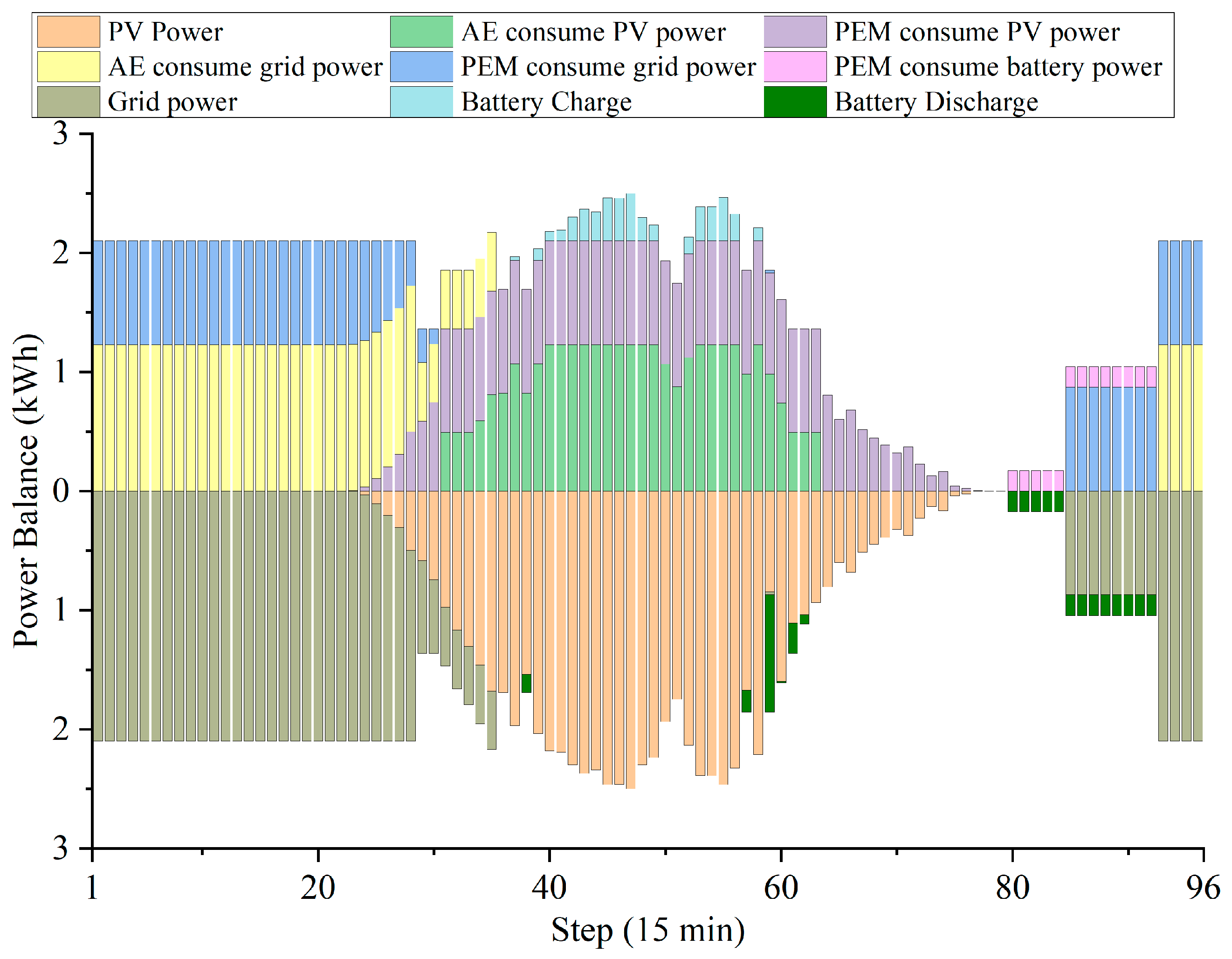
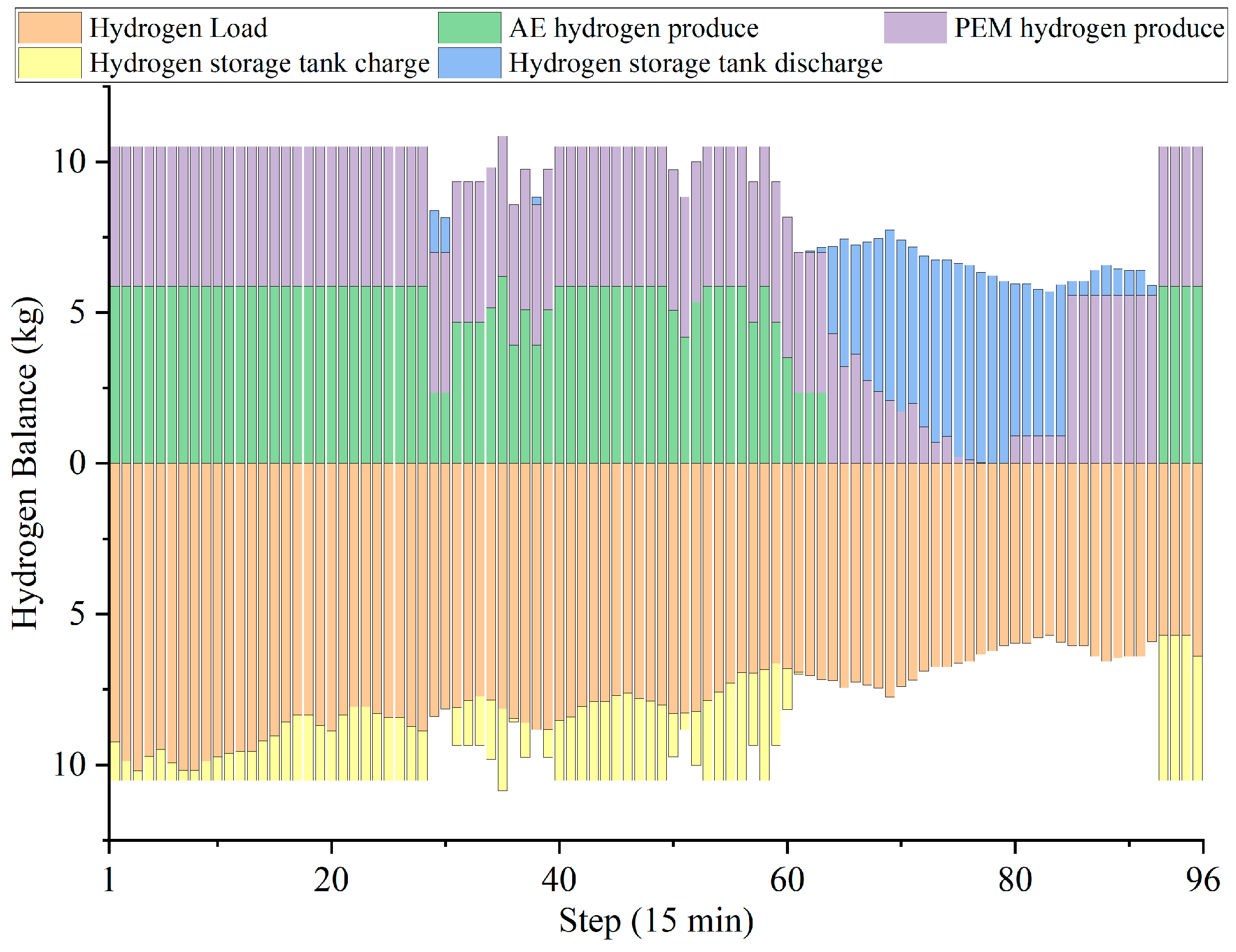
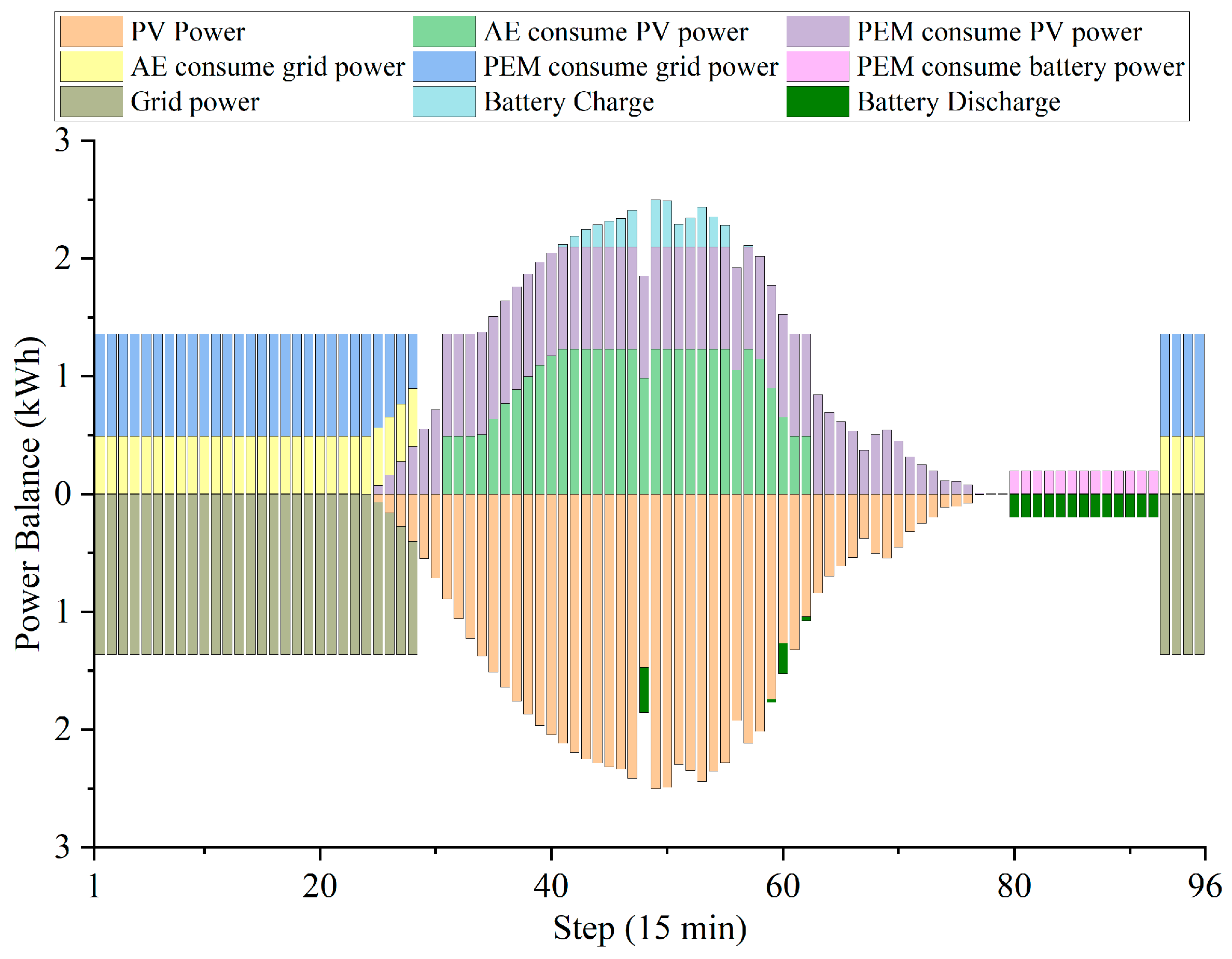
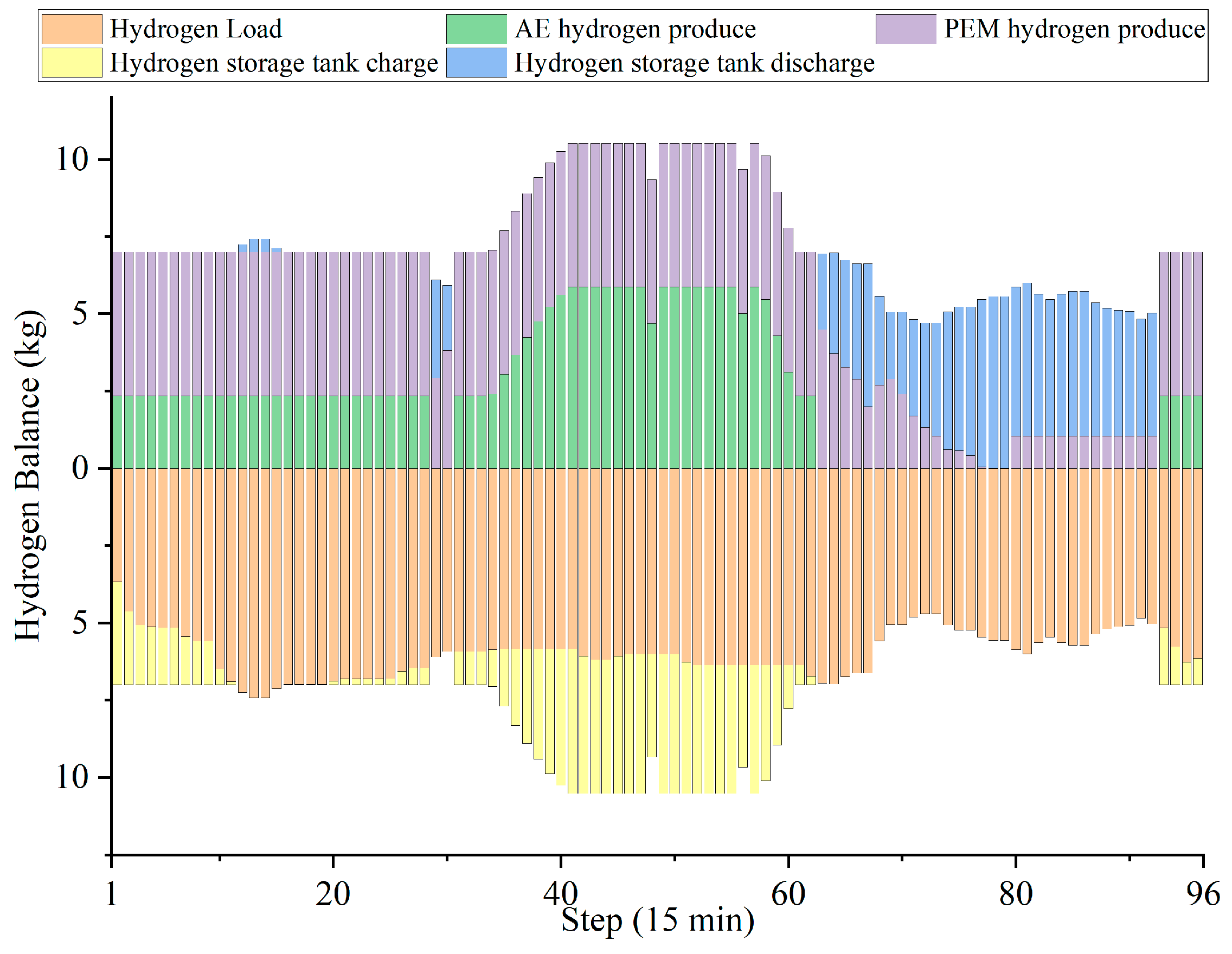
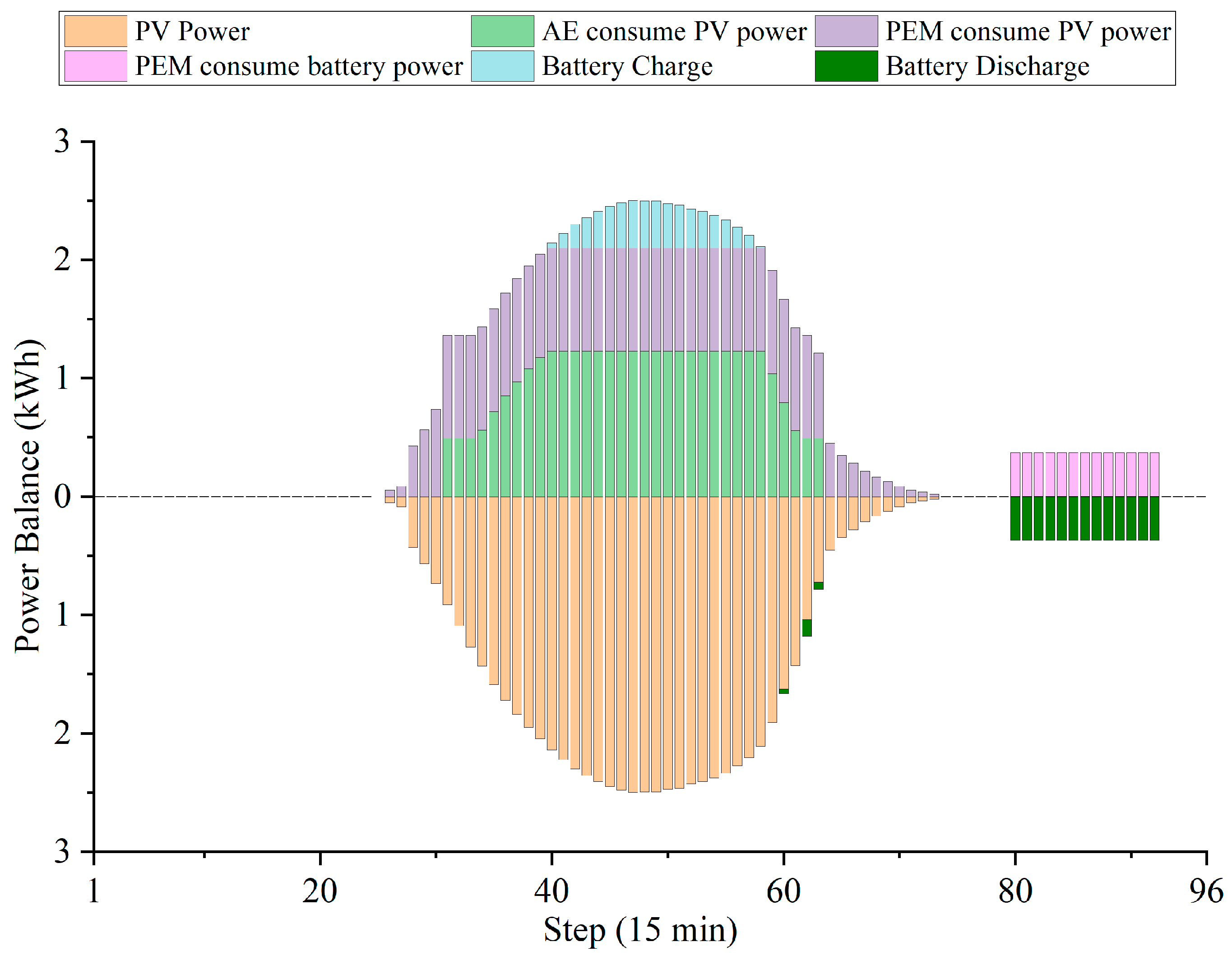
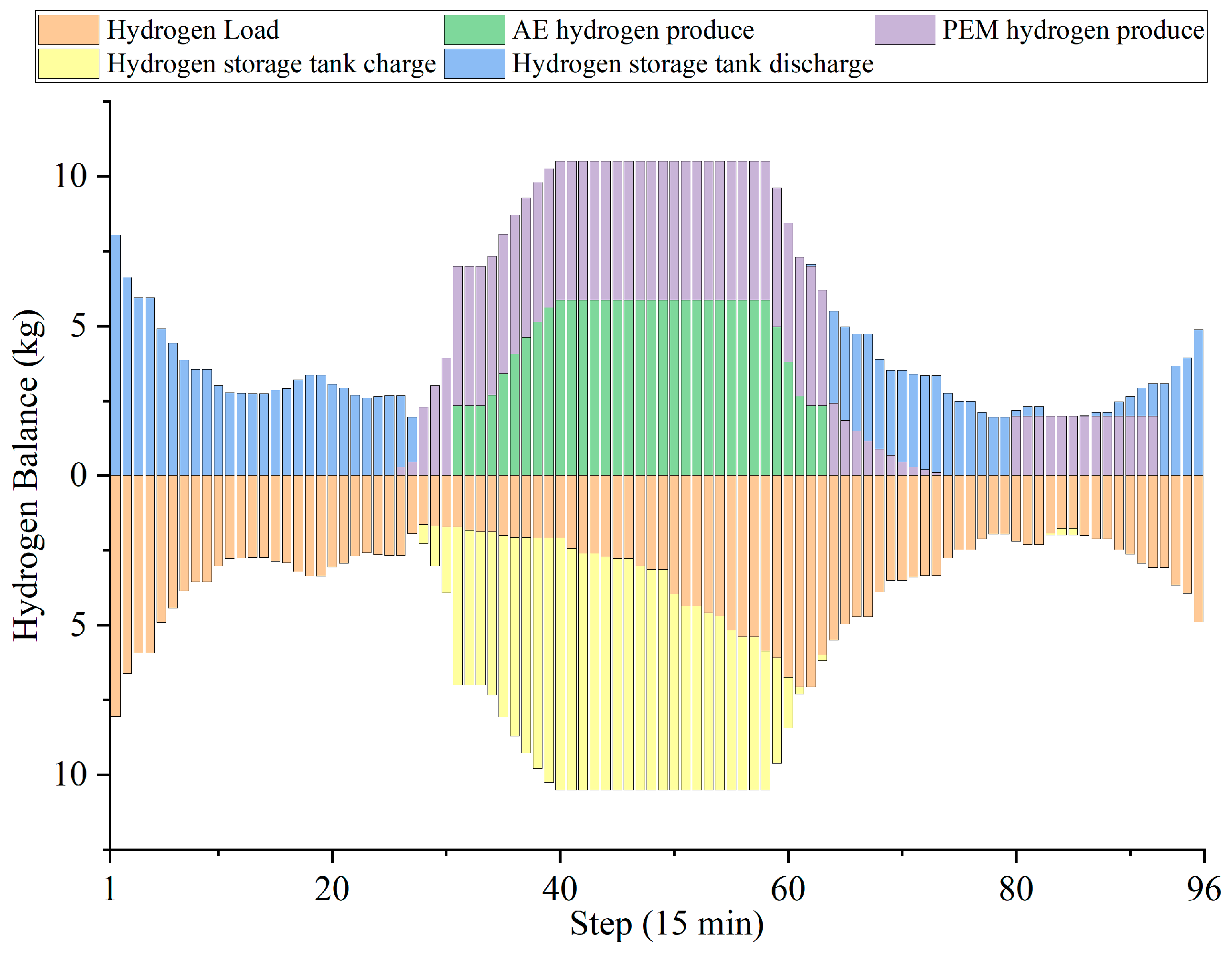
| Time Range | Price (USD) |
|---|---|
| 23:00–Next Day 7:00 | 0.0358 |
| 7:00–10:00 | 0.0753 |
| 10:00–12:00 | 0.1038 |
| 12:00–15:00 | 0.0753 |
| 15:00–21:00 | 0.1038 |
| 21:00–23:00 | 0.0753 |
| Equipment | Scheme 1 | Scheme 2 | Scheme 3 |
|---|---|---|---|
| AE (MW) | 2.41 | 0 | 1.228 |
| PEM (MW) | 0 | 1.922 | 0.871 |
| Hydrogen Storage Tank (m3) | 25 | 20 | 20 |
| Energy storage Battery (MWh) | 10 | 5 | 6 |
| Hydrogen Fuel Cell (kW) | 28 | 20 | 24 |
| Compressor (kW) | 100 | 98 | 98 |
| Capacitance Capacity (kWh) | 93 | 93 | 93 |
| Initial Investment Cost (USD) | 3,171,043 | 3,120,517 | 2,986,643 |
| Daily Operation Cost (USD) | 376.8 | 661.7 | 488.8 |
| A year Cost (USD) | 3,308,572 | 3,362,052 | 3,165,050 |
| Equipment | Station 1 | Station 2 | Station 3 | Station 4 |
|---|---|---|---|---|
| AE (MW) | 1.228 | 2.559 | 1.287 | 0.142 |
| PEM (MW) | 0.871 | 1.814 | 0.915 | 0.101 |
| Hydrogen storage tank (m3) | 20 | 10 | 20 | 5 |
| Energy storage battery (MWh) | 6 | 0 | 5 | 6 |
| Hydrogen fuel cell (kW) | 24 | 0 | 3 | 3 |
| Compressor (kW) | 98 | 204 | 102 | 6 |
| Capacitance capacity (kWh) | 93 | 93 | 93 | 93 |
| Initial investment Cost (USD) | 2,986,643 | 3,459,866 | 2,947,896 | 2,115,928 |
| Daily operation cost (USD) | 488.8 | 840.6 | 500.6 | 163.5 |
| A year cost (USD) | 3,165,050 | 3,766,732 | 3,130,656 | 2,175,636 |
| Equipment | Station 5 | Station 6 | Station 7 | Station 8 |
|---|---|---|---|---|
| AE (MW) | 0.539 | 1.019 | 0.569 | 1.804 |
| PEM (MW) | 0.382 | 0.722 | 0.406 | 1.281 |
| Hydrogen storage tank (m3) | 10 | 20 | 10 | 10 |
| Energy storage battery (MWh) | 32 | 6 | 31 | 0 |
| Hydrogen fuel cell (kW) | 157 | 36 | 150 | 0 |
| Compressor (kW) | 26 | 49 | 27 | 144 |
| Capacitance capacity (kWh) | 93 | 93 | 93 | 93 |
| Initial investment cost (USD) | 4,310,105 | 2,835,200 | 4,259,473 | 2,920,151 |
| Daily operation cost (USD) | 400 | 427.9 | 404.6 | 622.8 |
| A year cost (USD) | 4,456,116 | 2,991,407 | 4,407,209 | 3,147,547 |
| Typical Day 1 | Typical Day 2 | Typical Day 3 | |
|---|---|---|---|
| Power cost (kWh) | 38,903 | 30,054 | 18,744 |
| Electricity cost (USD) | 3182 | 1528 | 0 |
| Discarded PV power generation (kWh) | 0 | 0 | 0 |
| Excess hydrogen (kg) | 0 | 0 | 4.7 |
| Power sale quantity (kWh) | 0 | 0 | 94.6 |
| Profit from sale of electricity (USD) | 0 | 0 | 28.4 |
Disclaimer/Publisher’s Note: The statements, opinions and data contained in all publications are solely those of the individual author(s) and contributor(s) and not of MDPI and/or the editor(s). MDPI and/or the editor(s) disclaim responsibility for any injury to people or property resulting from any ideas, methods, instructions or products referred to in the content. |
© 2025 by the authors. Licensee MDPI, Basel, Switzerland. This article is an open access article distributed under the terms and conditions of the Creative Commons Attribution (CC BY) license (https://creativecommons.org/licenses/by/4.0/).
Share and Cite
Yan, Z.; Fan, Y.; Hou, J. Equipment Sizing and Operation Strategy of Photovoltaic-Powered Hydrogen Refueling Station Based on AE-PEM Coupled Hydrogen Production. Electronics 2025, 14, 1195. https://doi.org/10.3390/electronics14061195
Yan Z, Fan Y, Hou J. Equipment Sizing and Operation Strategy of Photovoltaic-Powered Hydrogen Refueling Station Based on AE-PEM Coupled Hydrogen Production. Electronics. 2025; 14(6):1195. https://doi.org/10.3390/electronics14061195
Chicago/Turabian StyleYan, Zheng, Yanfang Fan, and Junjie Hou. 2025. "Equipment Sizing and Operation Strategy of Photovoltaic-Powered Hydrogen Refueling Station Based on AE-PEM Coupled Hydrogen Production" Electronics 14, no. 6: 1195. https://doi.org/10.3390/electronics14061195
APA StyleYan, Z., Fan, Y., & Hou, J. (2025). Equipment Sizing and Operation Strategy of Photovoltaic-Powered Hydrogen Refueling Station Based on AE-PEM Coupled Hydrogen Production. Electronics, 14(6), 1195. https://doi.org/10.3390/electronics14061195






